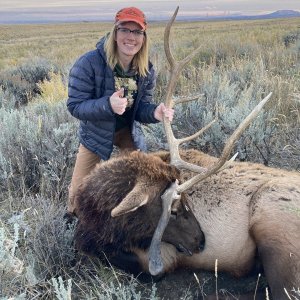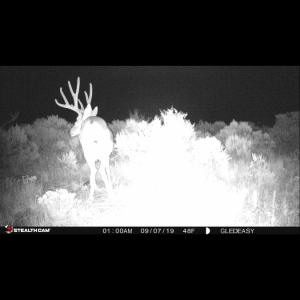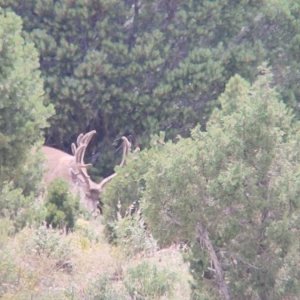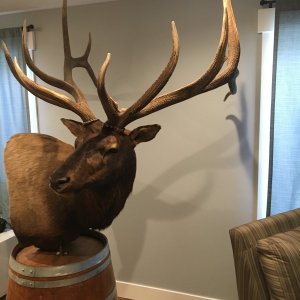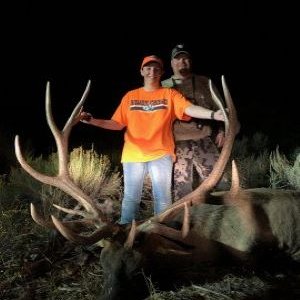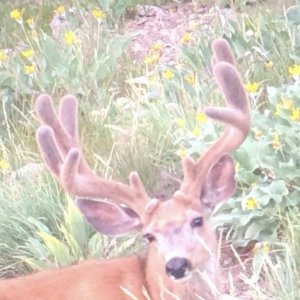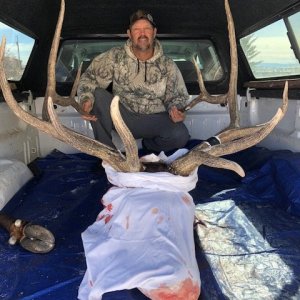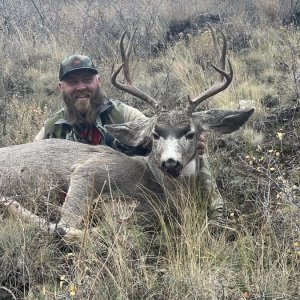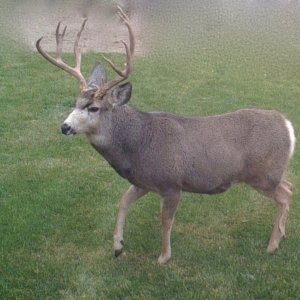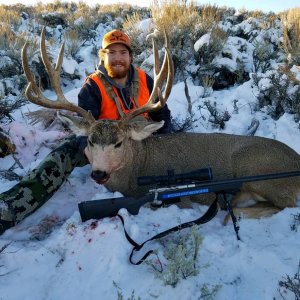Ever wonder how many deer are killed by cars in a typical year. I suspect the numbers are staggering. I work as a field adjuster for a relatively small insurance company, at least as compared to the likes of State Farm and Allstate. My territory is the middle portion of Wyoming from the Nebraska border to the Idaho border. For the last month or so, I've been averaging about one deer/car hit a day as part of my claims load. Given the number of drivers out there, I'd think statewide there has to be at least 50 - 100 deer hits a day during the winter months. Deer aren't killed in every automobile collision, but there is a very high mortality rate. Something to think about when you're driving down the road and seeing those deer carcasses laying next to the roadside...
You are using an out of date browser. It may not display this or other websites correctly.
You should upgrade or use an alternative browser.
You should upgrade or use an alternative browser.
Deer/car hits
- Thread starter Triple_BB
- Start date
P
patience
Guest
ever wonder how many people sit around and calculate the mortality rate of deer hit by cars. something to wonder about next time you see an insurance adjuster.
T
TFinalshot
Guest
I believe the state of pennsylvaina reports abour 15,000 car deer accidents per year!
I've always thought that people who kill deer with their cars should have to pay a fine, just like when they hit a cow. The der are wild, but they are property of the people of the state, and more and more, they have increasing values.
"State Farm estimates that 1.5 million vehicles collide with deer every year, resulting in 150 motorists deaths and $1.1 billion in vehicle damages."
Read the whole story "Worst 10 states for auto-deer collisions,"
at: http://money.cnn.com/2005/11/04/news/newsmakers/deer/
I've always thought that people who kill deer with their cars should have to pay a fine, just like when they hit a cow. The der are wild, but they are property of the people of the state, and more and more, they have increasing values.
"State Farm estimates that 1.5 million vehicles collide with deer every year, resulting in 150 motorists deaths and $1.1 billion in vehicle damages."
Read the whole story "Worst 10 states for auto-deer collisions,"
at: http://money.cnn.com/2005/11/04/news/newsmakers/deer/
Sure would be nice if we could somehow convince the insurance companies to spend that $1,100,000,000 on fences, deer underpasses and other things that would prevent the accidents from occurring in the future. Heck it would be better for everyone. The deer wouldn't get hit as often (more deer), it would save lives and save the insurance companies a lot of money in the long run as well.
NvrEnuf
NvrEnuf
Daxter
Very Active Member
- Messages
- 1,425
Here is a recent article from a Utah Newpaper based on research by UDOT and some researchers at Utah State University. I worked for a lady that did a radio collar study on mule deer in Northern Utah and more than 50% of her deer mortalities were from vehicles. Most of these were does and fawns too, the segment of the population that is most important for maintaining/growing the deer population. I really think we need to find more effective ways to reduce deer vehicle collisions, they are killing lots more deer than we realize.
Deer most likely to be hit on U.S. 89 in Utah
BY BRYCE PETERSEN JR.
Standard-Examiner staff [email protected]
LOGAN ? Two stretches of U.S. 89 in the Top of Utah rank as the state?s most dangerous for deer. And more deer are hit this month than any other, as they migrate lower to search for winter food.
It's a good time to pay attention to those yellow signs painted with the silhouette of a leaping deer. But if those have already blended into the background on your favorite route, watch for something more noticeable: Coming soon, large, portable, electronic signs flashing warnings in some of the most common places where deer migration routes cross busy roadways.
The signs debuted near Mantua this spring, when deer were headed to high summer range. They?ll be back very soon, along with such a sign near Perry, as deer begin following the snowline to winter range, said Darin Duersch, traffic engineer for UDOT?s Region 1.
A Utah Department of Transportation report ranks a stretch of U.S. 89 two miles south of Brigham City as the most likely spot in the state to hit a deer. A close second is U.S. 89 where it passes from Fruit Heights through Kaysville and into Layton.
Those are the worst spots on long, dangerous segments of the road as it funnels 55 mph-or-faster traffic along benches full of orchards and alfalfa fields ? tasty lures that can be deadly to deer and humans.
Slowing down
Noticeable signs top the list of short-term fixes to dangerous junctions of wildlife and human traffic, said Patricia Cramer, a Utah State University researcher.
?That's one thing we can do tomorrow, is get the word out to people ? 45 mph is key. If you can get people to slow down, that's a big help,? Cramer told an audience at USU last week. ?Most accidents would be prevented if people just slowed down.?
Cramer had just spent an hour showing slides and statistics on new ways highway departments are keeping apart cars and deer ? which make up about 95 percent of wildlife collisions. Deer-proof fences that funnel animals to underpasses and escape ramps that allow deer to get back off the road after they've breached deer-proof fences are examples.
Those things, unlike cautious drivers, take money and a commitment from people who build roads.
?You think about the human cost. It's very easy to justify these things over time,? said John Bissonette, a research ecologist with the U.S. Geological Survey and a professor in Utah State?s Department of Forest, Range and Wildlife Sciences.
Vehicles damaged
There are about 2,200 deervehicle collisions a year that injure a human or cause at least $10,000 of damage to a vehicle. That likely represents a fraction of deer deaths. One estimate, based on roadside counts in central Utah, puts the figure around 8,000 collisions a year. It could be twice that ? a figure that would approach the estimated 23,000 deer that die annually from legal hunting ? if studies suggesting as many as half of deer struck by cars wander off the road before they die are to be believed.
In the northern region, the Division of Wildlife Resources has responded to an average of 625 dead or injured deer a year over the last three years, an effort that takes about 313 hours and $1,800 in landfill fees a year.
Bissonette, who coordinates a team of students, professors and other researchers ? including Cramer ? studying the topic, has been trying for years to convince transportation officials that the cost of building alternate ways for deer to cross highways is worth it.
It's working, to a point.
New approach
Paul West, a wildlife biologist for UDOT, compiled an analysis of wildlife migration routes across Utah?s highways. The analysis, released in June, is already being used to correct some of the most pressing problems, mostly during improvements of major highways.
?Every project that UDOT has has to go through my scrutiny,? West said.
That doesn't mean every wildlife hazard is taken care of as part of every construction project. Budget constraints still modify, or kill, some additions.
?We could probably spend our entire road budget on wildlife issues and not solve them all,? West said.
But the issues are being considered, and earlier than ever. West noted that engineers are starting to come to him years before a project to look at needs on the route.
For instance, an underpass, designed by USU researchers and put in during a 2004 construction project, allows deer to cross Interstate 15 just south of its junction with Interstate 70. That dropped deer deaths from as many as 125 a year to ?almost zero? just months after it was completed, Bissonette said.
West notes that elk, which are less comfortable with even short tunnels, are not responding as well; they seem to have moved their crossing farther south and are being hit at a similar rate.
USU researchers and Division of Wildlife personnel are involved in the earliest planning stages of a 20-year widening project on U.S. 6 between Price and Spanish Fork. They are identifying critical areas and designing fences and bridges to allow wildlife crossings without breaking the budget.
?It just makes me happy to see some things happening,? Bissonette said. ?I've been working on this since the late 1980s, and it's just in the past three or four years that we've really started seeing some results. ... It's a changed world.?
Deer most likely to be hit on U.S. 89 in Utah
BY BRYCE PETERSEN JR.
Standard-Examiner staff [email protected]
LOGAN ? Two stretches of U.S. 89 in the Top of Utah rank as the state?s most dangerous for deer. And more deer are hit this month than any other, as they migrate lower to search for winter food.
It's a good time to pay attention to those yellow signs painted with the silhouette of a leaping deer. But if those have already blended into the background on your favorite route, watch for something more noticeable: Coming soon, large, portable, electronic signs flashing warnings in some of the most common places where deer migration routes cross busy roadways.
The signs debuted near Mantua this spring, when deer were headed to high summer range. They?ll be back very soon, along with such a sign near Perry, as deer begin following the snowline to winter range, said Darin Duersch, traffic engineer for UDOT?s Region 1.
A Utah Department of Transportation report ranks a stretch of U.S. 89 two miles south of Brigham City as the most likely spot in the state to hit a deer. A close second is U.S. 89 where it passes from Fruit Heights through Kaysville and into Layton.
Those are the worst spots on long, dangerous segments of the road as it funnels 55 mph-or-faster traffic along benches full of orchards and alfalfa fields ? tasty lures that can be deadly to deer and humans.
Slowing down
Noticeable signs top the list of short-term fixes to dangerous junctions of wildlife and human traffic, said Patricia Cramer, a Utah State University researcher.
?That's one thing we can do tomorrow, is get the word out to people ? 45 mph is key. If you can get people to slow down, that's a big help,? Cramer told an audience at USU last week. ?Most accidents would be prevented if people just slowed down.?
Cramer had just spent an hour showing slides and statistics on new ways highway departments are keeping apart cars and deer ? which make up about 95 percent of wildlife collisions. Deer-proof fences that funnel animals to underpasses and escape ramps that allow deer to get back off the road after they've breached deer-proof fences are examples.
Those things, unlike cautious drivers, take money and a commitment from people who build roads.
?You think about the human cost. It's very easy to justify these things over time,? said John Bissonette, a research ecologist with the U.S. Geological Survey and a professor in Utah State?s Department of Forest, Range and Wildlife Sciences.
Vehicles damaged
There are about 2,200 deervehicle collisions a year that injure a human or cause at least $10,000 of damage to a vehicle. That likely represents a fraction of deer deaths. One estimate, based on roadside counts in central Utah, puts the figure around 8,000 collisions a year. It could be twice that ? a figure that would approach the estimated 23,000 deer that die annually from legal hunting ? if studies suggesting as many as half of deer struck by cars wander off the road before they die are to be believed.
In the northern region, the Division of Wildlife Resources has responded to an average of 625 dead or injured deer a year over the last three years, an effort that takes about 313 hours and $1,800 in landfill fees a year.
Bissonette, who coordinates a team of students, professors and other researchers ? including Cramer ? studying the topic, has been trying for years to convince transportation officials that the cost of building alternate ways for deer to cross highways is worth it.
It's working, to a point.
New approach
Paul West, a wildlife biologist for UDOT, compiled an analysis of wildlife migration routes across Utah?s highways. The analysis, released in June, is already being used to correct some of the most pressing problems, mostly during improvements of major highways.
?Every project that UDOT has has to go through my scrutiny,? West said.
That doesn't mean every wildlife hazard is taken care of as part of every construction project. Budget constraints still modify, or kill, some additions.
?We could probably spend our entire road budget on wildlife issues and not solve them all,? West said.
But the issues are being considered, and earlier than ever. West noted that engineers are starting to come to him years before a project to look at needs on the route.
For instance, an underpass, designed by USU researchers and put in during a 2004 construction project, allows deer to cross Interstate 15 just south of its junction with Interstate 70. That dropped deer deaths from as many as 125 a year to ?almost zero? just months after it was completed, Bissonette said.
West notes that elk, which are less comfortable with even short tunnels, are not responding as well; they seem to have moved their crossing farther south and are being hit at a similar rate.
USU researchers and Division of Wildlife personnel are involved in the earliest planning stages of a 20-year widening project on U.S. 6 between Price and Spanish Fork. They are identifying critical areas and designing fences and bridges to allow wildlife crossings without breaking the budget.
?It just makes me happy to see some things happening,? Bissonette said. ?I've been working on this since the late 1980s, and it's just in the past three or four years that we've really started seeing some results. ... It's a changed world.?
>ever wonder how many people sit
>around and calculate the mortality
>rate of deer hit by
>cars. something to wonder about
>next time you see an
>insurance adjuster.
Won't work. Most folks are wondering how they're gonna get their deductible hidden in the deal or how they're going to get that unrelated damage included in on the same loss...
>around and calculate the mortality
>rate of deer hit by
>cars. something to wonder about
>next time you see an
>insurance adjuster.
Won't work. Most folks are wondering how they're gonna get their deductible hidden in the deal or how they're going to get that unrelated damage included in on the same loss...
J
JACKELOPE
Guest
i found this old article from the methow valley/winthrop area in washington state. it's our famous area for deer-car wrecks. it came out in 8/2003. just pieces of the article.
The signs display the year-to-date kill count and damage amount. So far in
2003, 66 deer have been dispatched, causing $95,000 in vehicle damage.
He says there are two types of people in the Methow Valley: those who have
hit a deer, and those who are going to.
The National Highway Traffic Safety Administration does not keep national
roadkill records, but Washington would not top such a list. Wisconsin
drivers kill about 50,000 deer and Pennsylvania has nearly 30,000, according
to the Washington Department of Transportation.
While the transportation workers have a messy job removing roadkill in the
summer, winter cleanups may not end with a trip to the eagle-feeding
grounds. If a deer is preserved well enough, it is taken to a butcher shop
in Winthrop where it is dressed, cut and packaged.
Under an agreement with some of the coastal Indian tribes on the other side
of the Cascade Mountains, that meat is given to the tribes for free. In
exchange, the Indians give up treaty hunting rights in the valley during the
winter.
The signs display the year-to-date kill count and damage amount. So far in
2003, 66 deer have been dispatched, causing $95,000 in vehicle damage.
He says there are two types of people in the Methow Valley: those who have
hit a deer, and those who are going to.
The National Highway Traffic Safety Administration does not keep national
roadkill records, but Washington would not top such a list. Wisconsin
drivers kill about 50,000 deer and Pennsylvania has nearly 30,000, according
to the Washington Department of Transportation.
While the transportation workers have a messy job removing roadkill in the
summer, winter cleanups may not end with a trip to the eagle-feeding
grounds. If a deer is preserved well enough, it is taken to a butcher shop
in Winthrop where it is dressed, cut and packaged.
Under an agreement with some of the coastal Indian tribes on the other side
of the Cascade Mountains, that meat is given to the tribes for free. In
exchange, the Indians give up treaty hunting rights in the valley during the
winter.
cmiddleton
Very Active Member
- Messages
- 1,214
11/5 06 outside mid west wyoming a trans am swirved to miss a deer and head oned a semi truck all were killed evn the truck driver. the deer made it though.
i will not swerve vary much to miss a deer. if i can, i will but not enough to hit the ditch or even the other lane. i have hit 4 deer in my life and had no body damage or injuries except the deers.
i hit 5 grouse at once and took out the head light the windshield and the antanna.
the moral of the story is what costs more your car or your life.
or i'd rather hit a deer than 5 grouse. glad the game warden didn't see that i think the limit on grouse is three and you are suppose to use a shot gun not a dodge.
itt is much more dangerous to freak out and try to miss one then it is to hit one.
i will not swerve vary much to miss a deer. if i can, i will but not enough to hit the ditch or even the other lane. i have hit 4 deer in my life and had no body damage or injuries except the deers.
i hit 5 grouse at once and took out the head light the windshield and the antanna.
the moral of the story is what costs more your car or your life.
or i'd rather hit a deer than 5 grouse. glad the game warden didn't see that i think the limit on grouse is three and you are suppose to use a shot gun not a dodge.
itt is much more dangerous to freak out and try to miss one then it is to hit one.
H
hoofsandhorns
Guest
It happens a lot. Here's a couple shots I took recently for a work related road safety presentation on deer strikes. ( Just so you know the speed on the sign is in Kilometers, about 60 miles an hour US)




oakbrush
Active Member
- Messages
- 423
It can happen fast. Check this out.
http://s115.photobucket.com/albums/n285/oakbrush/?action=view?t=DeerHit.flv
http://s115.photobucket.com/albums/n285/oakbrush/?action=view?t=DeerHit.flv
oakbrush
Active Member
- Messages
- 423
LAST EDITED ON Nov-16-06 AT 08:07PM (MST)[p]LAST EDITED ON Nov-16-06 AT 08:06?PM (MST)
LAST EDITED ON Nov-16-06 AT 08:01?PM (MST)
Well, I can't seem to get it to work. I think this one does.
http://s115.photobucket.com/albums/n285/oakbrush/?action=view?t=DeerHit.flv
LAST EDITED ON Nov-16-06 AT 08:01?PM (MST)
Well, I can't seem to get it to work. I think this one does.
http://s115.photobucket.com/albums/n285/oakbrush/?action=view?t=DeerHit.flv
A
AZbowhntr
Guest
I had to cut and paste but it worked. The last part of the link is not highlighted. That buck just comes out of nowhere.
I remember one year when I still lived in Idaho that we had a real hard winter and the deer migrated all the way down to the canyon rim between Jerome and Twin Falls. Talk about a deer holocaust. There were dead deer everywhere.
I remember one year when I still lived in Idaho that we had a real hard winter and the deer migrated all the way down to the canyon rim between Jerome and Twin Falls. Talk about a deer holocaust. There were dead deer everywhere.
Similar threads
- Replies
- 1
- Views
- 428


